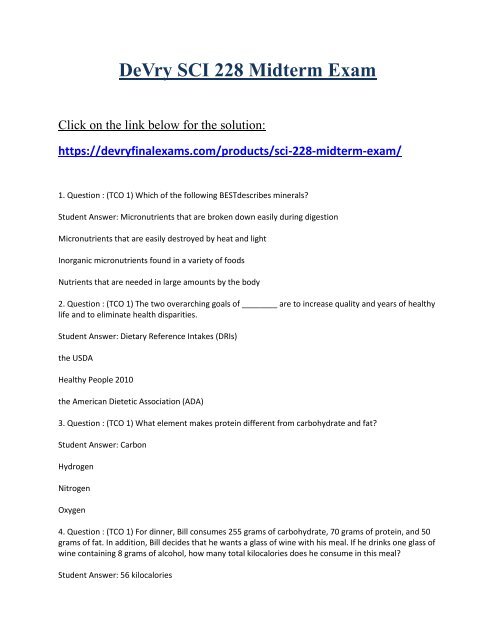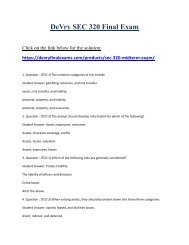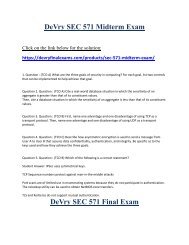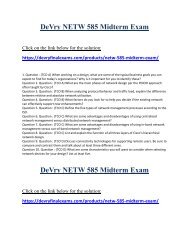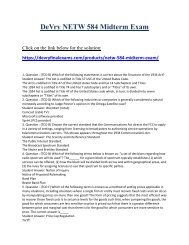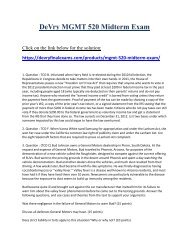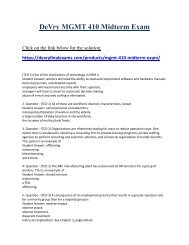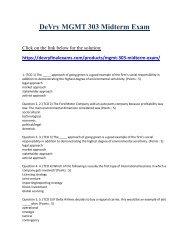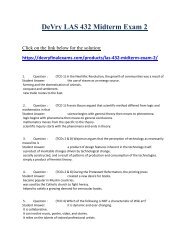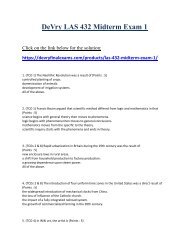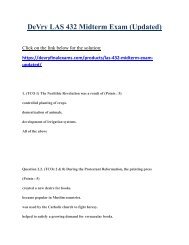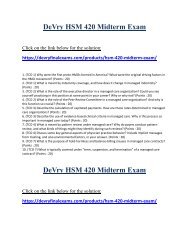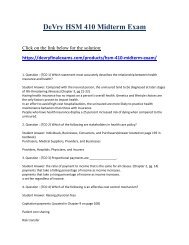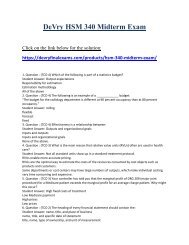SCI 228 Midterm Exam
You also want an ePaper? Increase the reach of your titles
YUMPU automatically turns print PDFs into web optimized ePapers that Google loves.
DeVry <strong>SCI</strong> <strong>228</strong> <strong>Midterm</strong> <strong>Exam</strong><br />
Click on the link below for the solution:<br />
https://devryfinalexams.com/products/sci-<strong>228</strong>-midterm-exam/<br />
1. Question : (TCO 1) Which of the following BESTdescribes minerals?<br />
Student Answer: Micronutrients that are broken down easily during digestion<br />
Micronutrients that are easily destroyed by heat and light<br />
Inorganic micronutrients found in a variety of foods<br />
Nutrients that are needed in large amounts by the body<br />
2. Question : (TCO 1) The two overarching goals of ________ are to increase quality and years of healthy<br />
life and to eliminate health disparities.<br />
Student Answer: Dietary Reference Intakes (DRIs)<br />
the USDA<br />
Healthy People 2010<br />
the American Dietetic Association (ADA)<br />
3. Question : (TCO 1) What element makes protein different from carbohydrate and fat?<br />
Student Answer: Carbon<br />
Hydrogen<br />
Nitrogen<br />
Oxygen<br />
4. Question : (TCO 1) For dinner, Bill consumes 255 grams of carbohydrate, 70 grams of protein, and 50<br />
grams of fat. In addition, Bill decides that he wants a glass of wine with his meal. If he drinks one glass of<br />
wine containing 8 grams of alcohol, how many total kilocalories does he consume in this meal?<br />
Student Answer: 56 kilocalories
540 kilocalories<br />
1,675 kilocalories<br />
1,806 kilocalories<br />
5. Question : (TCO 1) Jose’s lunch contains 121 grams of carbohydrate, 40 grams of protein, and 25<br />
grams of fat. What percent of kilocalories in this meal come from fat?<br />
Student Answer: 19%<br />
26%<br />
34%<br />
42%.<br />
6. Question : (TCO 1) Which of the following is an example of disease that is directly caused by a<br />
nutritional deficiency?<br />
Student Answer: Anemia<br />
Cancer<br />
Osteoporosis<br />
Heart disease<br />
7. Question : (TCO 2) Which of the following snacks will have the highest satiety value, assuming the<br />
calories and relative size are similar?<br />
Student Answer: slice of whole-grain bread<br />
piece of cheese<br />
glass of whole milk<br />
glass of skim milk<br />
8. Question : (TCO 2) The percent daily values (%DV) on food labels are based on the:<br />
Student Answer: DRIs.<br />
RDIs.<br />
DRVs.
all of these<br />
9. Question : (TCO 2) The government agency that regulates food labeling in the United States is the:<br />
Student Answer: USDA.<br />
FDA.<br />
CDC.<br />
all of these<br />
10. Question : (TCO 2) The standard used to estimate the daily nutrient needs of half of all healthy<br />
individuals is:<br />
Student Answer: EAR.<br />
AI.<br />
RDA.<br />
UL.<br />
11. Question : (TCO 2) The smallest units of matter that normally cannot be broken down are:<br />
Student Answer: atoms.<br />
molecules.<br />
cells.<br />
lipids.<br />
12. Question : (TCO 2) The Dietary Guidelines to Americans has defined physically active as a:<br />
Student Answer: minimum of 60 minutes of moderate activity most days.<br />
minimum of 30 minutes of moderate activity most days.<br />
minimum of 15 minutes of intense activity most days.<br />
total of 8 hours of moderate activity per week.<br />
13. Question : (TCO 3) In which organ does the majority of water absorption occur?<br />
Student Answer: mouth<br />
stomach
small intestine<br />
large intestine<br />
14. Question : (TCO 3) Which of the following would be an appropriate treatment approach for someone<br />
suffering from GERD?<br />
Student Answer: surgical removal of the gallbladder<br />
omission of all lactose foods<br />
antibiotic therapy<br />
lose weight and quit smoking<br />
15. Question : (TCO 3) The first section of the small intestine is called the:<br />
Student Answer: bile duct.<br />
duodenum.<br />
jejunum.<br />
ileum.<br />
16. Question : (TCO 3) Digestion and absorption occur at the ________ level.<br />
Student Answer: tissue<br />
organ<br />
system<br />
organism<br />
17. Question : (TCO 3) What is the term that describes the process in which nutrients pass through the<br />
wall of the gastrointestinal tract?<br />
Student Answer: digestion<br />
absorption<br />
elimination<br />
segmentation
1. Question : (TCO 4) In the absence of carbohydrate, ________ are produced from the incomplete<br />
breakdown of body fat.<br />
Student Answer: amyloses<br />
amylases<br />
ketones<br />
bacteria<br />
2. Question : (TCO 4) Without sufficient ________, the colon gets too little exercise and becomes weak.<br />
Student Answer: calories<br />
protein<br />
fiber<br />
water<br />
3. Question : (TCO 4) Diabetes is a condition in which the body doesn’t process ________ properly.<br />
Student Answer: vitamins<br />
protein<br />
carbohydrate<br />
fat<br />
4. Question : (TCO 4) After a meal, which hormone is responsible for moving glucose into the body’s<br />
cells?<br />
Student Answer: glucagon<br />
estrogen<br />
CCK<br />
insulin<br />
5. Question : (TCO 4) The term complex carbohydrates refers to:<br />
Student Answer: monosaccharides.<br />
disaccharides.
polysaccharides.<br />
glucose.<br />
6. Question : (TCO 4) Which of the following carbohydrates is the end product of photosynthesis?<br />
Student Answer: glycogen<br />
galactose<br />
lactose<br />
glucose<br />
7. Question : (TCO 4) Over 16 million Americans have diabetes. Which of the following is the most<br />
prevalent form of diabetes?<br />
Student Answer: type 1<br />
type 2<br />
gestational<br />
pediatric<br />
8. Question : (TCO 4) In the body, the major storage sites for glycogen are the:<br />
Student Answer: muscles and liver.<br />
kidney and muscles.<br />
liver and kidney.<br />
liver and pancreas.<br />
9. Question : (TCO 1-6) All of the following are protective responses to encountering food-borne<br />
microbes EXCEPT:<br />
Student Answer: vomiting and diarrhea.<br />
increased production of white blood cells.<br />
fever.<br />
decreased metabolic rate.<br />
10. Question : (TCO 1-6) The main symptom associated with Clostridium botulinumintoxication is:
Student Answer: diarrhea.<br />
paralysis.<br />
anemia.<br />
jaundice.<br />
11. Question : (TCO 1-6) An estimated ________ of all chicken eggs in the U.S. are contaminated with<br />
Salmonella.<br />
Student Answer: one-fifth<br />
one-fourth<br />
one-third<br />
one-half<br />
12. Question : (TCO 1-6) Which of the following additives gives ham, hot dogs, and bologna their pink<br />
color?<br />
Student Answer: sulfites<br />
BHT/BHA<br />
nitrates/nitrites<br />
propionic acid<br />
13. Question : (TCO 1-6) Why do fungi rarely cause food infection?<br />
Student Answer: Few species of fungi cause serious illness.<br />
Fungal growth makes food look unappealing.<br />
Fungal growth makes food taste unappealing.<br />
All of these are reasons fungi rarely cause food infection.<br />
14. Question : (TCO 1-6) The primary symptom of Giardia infection is:<br />
Student Answer: jaundice.<br />
diarrhea.<br />
dementia.
anemia.<br />
15. Question : (TCO 1-6) The primary method used to preserve seafood is:<br />
Student Answer: adding salt.<br />
smoking.<br />
drying.<br />
adding sugar.<br />
16. Question : (TCO 1-6) Hepatitis A is a food-borne virus that can result in ________ damage.<br />
Student Answer: nerve<br />
intestinal<br />
liver<br />
muscle<br />
17. Question : (TCO 1-6) Bovine spongiform encephalopathy is a food-borne illness also known as:<br />
Student Answer: mad cow disease.<br />
typhoid fever.<br />
Norwalk virus.<br />
hepatitis A.<br />
1. Question : (TCO 5) What is the primary form of lipid in the diet?<br />
Student Answer: Sterols<br />
Triglycerides<br />
Phospholipids<br />
Glycerols<br />
2. Question : (TCO 5) Which of the following statements is FALSE regarding the process of<br />
hydrogenation?<br />
Student Answer: Hydrogenation creates trans fatty acids.<br />
Hydrogenation is the process in which hydrogen atoms are added to double bonds.
Hydrogenation creates a heart-healthy product.<br />
Hydrogenation makes a product more solid at room temperature.<br />
3. Question : (TCO 5) Which of the following ingredients would alert you to the presence of trans-fatty<br />
acids in a product?<br />
Student Answer: Hydrogenated vegetable oil<br />
Lecithin<br />
Liquid corn oil<br />
Vitamin E<br />
4. Question : (TCO 5) The two essential fatty acids are:<br />
Student Answer: cholesterol and bile.<br />
linoleic and alpha-linolenic acid.<br />
butyric and stearic acid.<br />
cis and trans.<br />
5. Question : (TCO 5) The process of adding hydrogen to an unsaturated fatty acid and creating a more<br />
solid fat is called:<br />
Student Answer: emulsification.<br />
pressurization.<br />
hydrogenation.<br />
deamination.<br />
6. Question : (TCO 5) To facilitate the digestion of dietary fats, the gallbladder stores and releases a<br />
substance known as:<br />
Student Answer: lipase.<br />
bile.<br />
hydrochloric acid.<br />
bicarbonate.<br />
7. Question : (TCO 5) Where in the body are the majority of triglycerides stored for future energy needs?
Student Answer: Lipoproteins<br />
Beta cells of the pancreas<br />
Liver<br />
Adipose tissue<br />
8. Question : (TCO 5) As of January 1, 2006, the U.S. Food and Drug Administration will require food<br />
manufacturers to list ________ content on the Nutrition Facts Panel of their products.<br />
Student Answer: phospholipid<br />
sterol<br />
essential fatty acid<br />
trans fatty acid<br />
9. Question : (TCO 6) The absorption of proteins occurs in the:<br />
Student Answer: stomach.<br />
small intestine.<br />
large intestine.<br />
liver.<br />
10. Question : (TCO 6) Which of the following statements is FALSE?<br />
Student Answer: HCl denatures protein to allow digestive enzymes to break down the protein.<br />
HCl inhibits the digestion of fat so it does not compete with protein digestion.<br />
HCl untangles the strands of protein and breaks the peptide bonds.<br />
HCl activates pepsin from pepsinogen.<br />
11. Question : (TCO 6) Two amino acids are joined together by a peptide bond to form a dipeptide. What<br />
is the by-product of this process?<br />
Student Answer: Ammonia<br />
Water<br />
Carbon dioxide<br />
Hydrochloric acid
12. Question : (TCO 6) Which of the following health problems has been associated with high protein<br />
intakes?<br />
Student Answer: Elevated blood cholesterol<br />
Marasmus<br />
Edema<br />
Sickle cell anemia<br />
13. Question : (TCO 6) Which of the following is a genetic disorder resulting in debilitating protein<br />
abnormalities?<br />
Student Answer: Cystic fibrosis<br />
Mad cow disease<br />
Acidosis<br />
Kwashiorkor<br />
14. Question : (TCO 6) The process through which mRNA copies genetic information from DNA and<br />
carries it to the ribosome is called:<br />
Student Answer: translation.<br />
deamination.<br />
denaturation.<br />
transcription.<br />
15. Question : (TCO 6) Proteases are:<br />
Student Answer: protein messengers that are released from storage in response to an alteration in the<br />
body’s homeostasis.<br />
transport proteins that move substances throughout the body.<br />
defense proteins that attack foreign bacteria, viruses, and toxins.<br />
enzymes that break down protein.<br />
16. Question : (TCO 6) During the process of protein synthesis, ________ is the step in which messenger<br />
RNA is decoded into an amino acid sequence at the cell’s ribosome.<br />
Student Answer: transcription
translation<br />
deamination<br />
denaturation<br />
DeVry <strong>SCI</strong> <strong>228</strong> <strong>Midterm</strong> <strong>Exam</strong><br />
Click on the link below for the solution:<br />
https://devryfinalexams.com/products/sci-<strong>228</strong>-midterm-exam/


